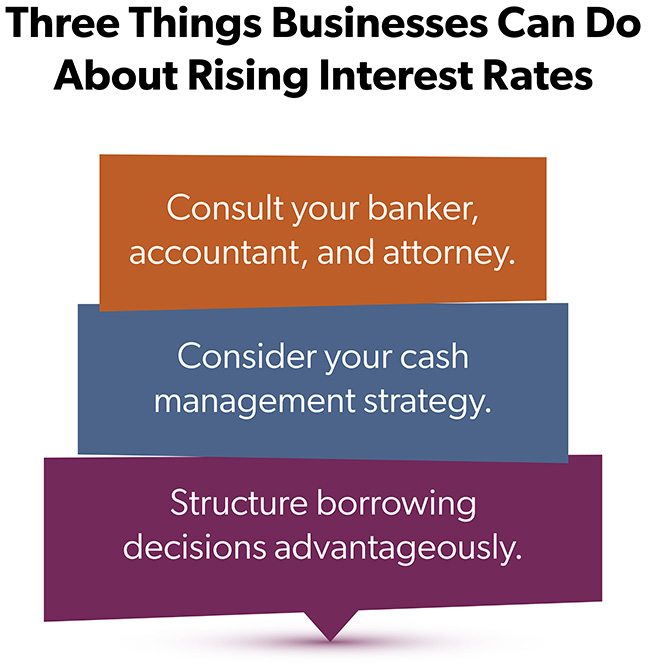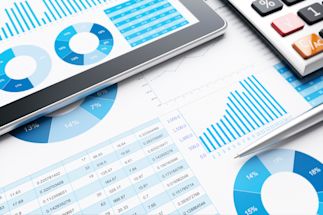Over the past several months, the Federal Reserve has been increasing interest rates and indicated they would likely continue until inflation is under control. This led economists and others to warn about worst-case scenarios, including a recession. Amidst the chaos and noise, it can be difficult to understand how increasing interest rates, and subsequent reactions, might affect businesses.
As a bank focused on business, our clients rely on us to help them navigate volatile economic conditions. This article recaps what’s happening, how interest rate hikes affect businesses and other banks, and offers some advice to help position your business — or bank — for the future.
Recent History Of Decreasing And Increasing Interest Rates
Going back to The Great Recession of 2008, to stimulate the economy the Fed lowered rates close to zero and they stayed that way for a long time. In 2016, the economy started to heat up and the Fed began increasing interest rates to keep inflation in the target range of 2-2.5%.
In late 2019, COVID-19 sparked severe economic impacts on the global economy. In response, the Fed lowered rates to almost zero to drive demand. At the same time, federal loan programs, like the Paycheck Protection Program (PPP), provided further support and supplied businesses with reserve liquidity, helping with demand and leading to increased levels of employment.
However, supply chain issues emerged, and, in many cases, companies could not get raw materials to make products like cars and homes. This is classic supply and demand; the supply chain pinched availability of raw materials and finished goods, so we began paying more for them. As an example, the cost of building materials skyrocketed, impacting housing and tenants, who paid higher rents and demanded increased wages to cover rising costs.
In a perfect world, companies would figure out how to source more raw materials and make more products. However, that’s not easy to solve.
Inflation In 2021
As late as fall of 2021, the Fed still labeled inflation as “transitory” because they felt higher prices were caused by a temporary COVID-19 hangover. They felt supply chain issues would resolve, the market would adjust, and prices would revert to normal. However, over time, the Fed’s language started to change. They spoke about certain categories where inflation was more sustained, but still believed the overall picture was manageable.
As it became evident these issues would take longer to resolve, the Fed signaled that higher prices were problematic, more sustained, and spoke more emphatically about increasing interest rates more quickly to dampen inflation. The Consumer Price Index, that famous “basket of goods,” started showing more key components experiencing significant price increases. It all felt incremental — until it wasn’t.
Russian Invasion Of Ukraine
In February 2022, Russia invaded Ukraine, causing a huge disruption of the European and world economies. Western nations worked to act in an organized fashion to punish Russia by not buying oil and imposing other economic sanctions. Among other things, this began to impact the flow of oil, leading to higher gas prices.
All these price factors affect how people feel about their available income, whether they go on vacation, buy a new home or a car, or whether they stop spending money, which can lead to a recession.
The Fed’s Interest Rate Hikes
Increasing interest rates is a way for the Fed to control inflation. Higher interest rates make it more costly for businesses to borrow money through loans and lines of credit and affect how much interest you pay on your credit card or home purchases. The impact of this generally ripples through the overall economy.
In September of 2022, the Fed raised interest rates by 75bps (basis points) for the third consecutive Federal Open Market Committee (FOMC) meeting. These 75 bps increases are a more aggressive action compared to more typical Fed rate increases, which, in the past, moved in 25 bps increments. In fact, it was the largest interest rate hike since 1994. The latest news indicates markets expect the Fed to raise rates another 75 bps in November and a majority expect it to raise rates another 50bps in December.
The Fed faces a difficult balancing act. In concept, it is an effort to slow things down in a moderate, more controlled way, giving the economy time to adjust and rebalance, with reduced inflation as a desired result. However, if consumer demand drops too rapidly, we risk dipping into a recession in which the economy shrinks.
How Are Businesses Affected By The Feds Raising Interest Rates?
As previously discussed, in the short term, rising interest rates increase borrowing costs. This could impact purchasing and investment decisions for both businesses and consumers, cooling demand. It is important to consider how this may affect your business, including your tactics and strategies for the next few years.
For instance, if your company has plans to invest in automation because you can’t find enough workers, consider that it may take more time to acquire the necessary equipment and robotics and the project costs may change. These factors alone can impact your ultimate return on investment for the automation project. With these considerations, how might you adjust your approach? Will it affect your firm’s sales or margins?
On a more personal level, either for business leaders or employees, how do changes and volatility in financial markets influence investment decisions, business succession strategies, or retirement plans?
What Can Businesses Do About Interest Rate Hikes?
It’s difficult to predict where we’re headed in the long term, but we can take hope in some basic truths and offer our perspective for the coming months and quarters.
1. Consult your banker, accountant, and attorney. Relationships with these experts are very important at this time, much more so than when everything is going great. Life is easy when demand is strong and rates are low. These key partners, especially those with experience in your industry, can help you get through chaotic times. Think of them as an extension of your team to provide individual advice and insight. You should be able to bring your plans or scenarios to your trusted advisors to assess viability and how they impact the economics of your decisions. Sometimes these partners say things that are tough to hear, but honest communication both ways is important in any long-term relationship. Bankers should provide best practices, insight, advice, and ideas to help you get to a good position.
2. Consider your cash management strategy. Your bank’s Treasury Management advisor can help review your current practices to optimize your treasury or accounting function. Our Treasury Management professionals regularly talk to business leaders about their cash conversion cycle — how quickly the business collects money versus the pace at which you send money out the door. That can have a material impact on your borrowing needs, your line of credit, and interest expense on your income statement. We have tools and techniques to accelerate cash collection and slow down outflows to vendors, and to improve efficiency in your back office.
While every business and industry is unique, maintaining cash flow is vital to success. Consider how rising interest rates affects your business in each of these situations:
- Borrowing money in a rising rate environment becomes more expensive for both operating lines of credit and term loans through higher borrowing and capital costs.
- Operating lines are impacted quickly as many lines of credit are repriced monthly.

- Working capital tied to holding inventory and accounts receivable becomes more costly and negatively impacts cash flow. Maintaining good working capital discipline is important to the company’s operations.
- Forecasting sales and the associated inventory requirements is important to hold inventory costs stable and not grow inventory levels too large.
- On the receivables side, collections become even more important. Your customers may try to maximize their liquidity position by holding on to cash longer, which results in your accounts receivable hanging longer on your balance sheet — and at a cost.
In the low-rate, low-return environment of the past several years, there have not been many options for deploying your cash. However, in a rising-rate environment, businesses with liquidity may want to consider different possibilities for operating, reserve, and strategic cash, while not losing sight of risk tolerance. Do you have an investment policy? If yes, it may be time to revisit it; if not, this is likely a good time to establish one considering current economic conditions. Alternatively, is now the time to reduce leverage for your business better by retiring debt with excess liquidity?
3. Structure borrowing decisions advantageously. If you are about to buy a piece of equipment, real estate, or considering an acquisition, be sure you know the return for that investment decision in basic terms. Rates may reach a level that impacts these assumptions. A trusted banking partner can advise you about how to structure a loan, including evaluating the amount of cash into the transaction, trade-offs relative to longer or shorter amortizations, and the overall debt capacity of your firm. You should expect a relationship-focused banker to welcome good, open communications between the bank and your company around the appropriate way to approach borrowing decisions.
What Can Businesses Do About Interest Rate Hikes?
With several decades of experience managing bank balance sheets, our Bank Consulting team helps other banks implement financial strategies to manage risk. Higher interest rates impact banks in many ways, including:
- With interest rates rising at the fastest pace in 40 years, bankers will need to adjust loan and deposit pricing to manage earnings and to provide services to clients in line with current market expectations.
- Government stimulus packages provided banks with very low cost liquidity during the pandemic, however, liquidity is leaving banks for higher-priced alternatives paying higher interest rates. In some cases, banks welcome the deposit runoff, but many banks need deposits to fund loan growth. Through the end of the year, banks will need to rapidly increase deposit rates, something banks didn’t have to do after the Great Recession.
- Loan rates are increasing rapidly as Fed interest rate hikes brought the Prime lending rate to 6.25 currently. With future interest rate hikes expected, the Prime rate will increase to 7.50% by year end.
- Lastly, one of the consequences of Fed tightening is a strong probability of the economy entering into a recession within the next 12 months. Banks will have to pay very close attention to credit and likely will need to increase credit spreads on loan offerings to protect against losses. In conclusion, banks will need to use their asset/liability models to run multiple stress scenarios and implement strategies to manage risk in these challenging times.
Final Thoughts On Navigating Rising Interest Rates
Sometimes it takes difficult times to emerge a stronger business or a stronger bank. We hear it quite often when the economy is challenging: our clients appreciate the hands-on, relationship focus we take, and they depend on our guidance. If you feel your organization would benefit from this type of partner, we welcome the opportunity to start a conversation.
Contributors: Kevin Kane, Jerimiah Janssen, Bill Uelmen
Last Updated: 5/17/23



